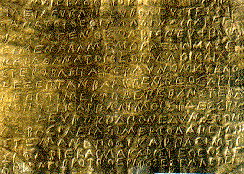 |
ORPHEUSSome Notes |
Orphic Lamella, IV. B.C., Thurii |
I. He is a THRACIAN (same area, near Mount Pangaeus, as Dionysus' enemy LYCURGUS and Heracles' foe DIOMEDES and his cannibalistic horses)
- -an early follower of DIONYSUS, but later against human and blood sacrifices.
- -said to be a son of APOLLO and CALLIOPE (The Muse from the Myrrha and Adonis story), or the son of Oeagrus, a king.
- -noted as a MUSICIAN, lyre-player (Apollonian trait), and a magician. He could charm the birds out of the trees (cf. St. Francis of Assisi, St. Anthony of Padua and the fishes) and even make trees dance.
II. He went on the expedition with JASON AND THE ARGONAUTS, in the ship ARGO (the ship designed by Athena).
- -On the way to COLCHIS, he introduced the sailors (among them Heracles) to the `Samothracian Mysteries').
- -On the way back, he helped the crew to avoid the SIRENS (from the Demeter and Persephone story) by covering their seductive but deadly sounds with his lyre playing.
III. MARRIAGE WITH EURYDICE: (She is a nymph, either a Naiad or a Dryad)
- -Shortly after her marriage she is chased through a field (where she is gathering posies) by ARISTEAS (the `Bee-Man') (Vergil, Georgics Book IV)
- -A serpent lurking in the grass (the original snake-in-the-grass) bites her and she dies, descending to the House of Hades.
- -ORPHEUS descends to the House of Hades to try to rescue her; he uses the entrance at Tenaerum in Laconia (Sparta).
- -HADES & PERSEPHONE agree to allow EURYDICE (`wide-judging') to go, if Orpheus can keep from looking at her until she is above ground again. He fails, and Eurydice must return to Hades.
IV. ORPHEUS returns to Thrace, where he is destroyed by native Thracian girls (of the Ciconian tribe), for one of the following reasons:
- (a) He switched to boys exclusively after his failed marriage;
- (b) He had not properly honored Dionysus, whose devotees they were (Maenads, Bacchae, Bacchantes);
- (c) Aphrodite inspired the Ciconian women because of Calliope's judgment in favor of Demeter in the Adonis incident;
- (d) The Ciconian women each wanted him, and they ripped him apart (thereby making him the patron saint of rock stars).
- AT HIS RESTING PLACE (LIBETHRA), near Mount Olympus, it is said that the nightingales sing more sweetly than any place else in the whole wide world.
- THE HEAD OF ORPHEUS floated down the HEBRUS (or is it the HALIACMON) River and out to sea. It turned up on the beach of the island of LESBOS, where an oracle of Orpheus was founded at ANTISSA.
- HIS LYRE was placed in the sky by the gods, and became the constellation LYRA.
References:
Apollodorus I.3.2; Ovid, Metamorphoses 10. 1-85; 11. 1-84;
Vergil Georgics 4. 453-527;
Apollonius of Rhodes Voyage of the Argo.
W. K. C Guthrie, Orpheus and Greek Religion (London: Methuen 1952) [reprinted: Princeton 1993].
Walter Burkert, Greek Religion (Cambridge: Harvard 1985), Ch. 6.2.
© J.P. Adams Revised 10/3/1996.